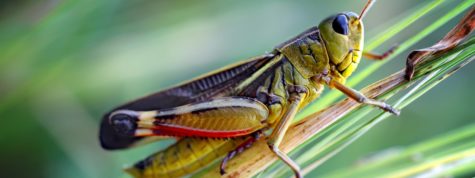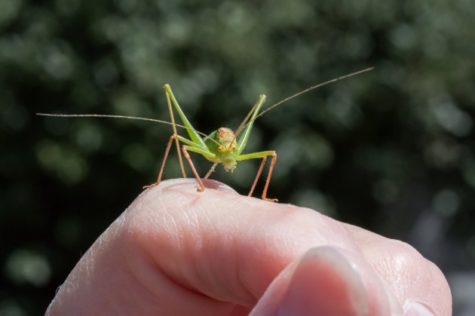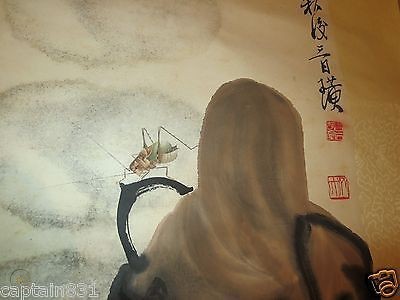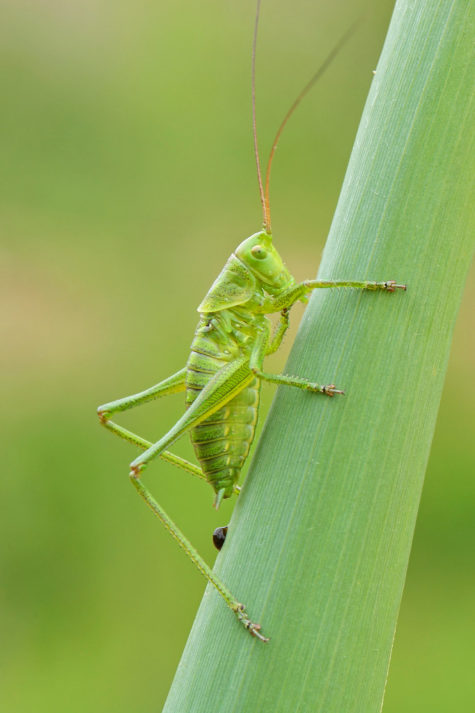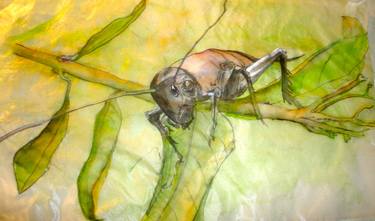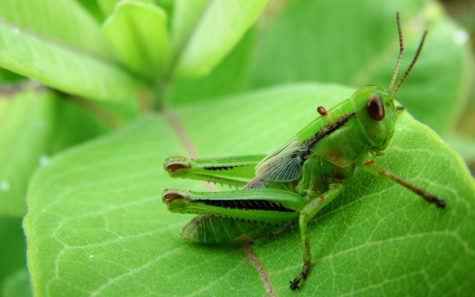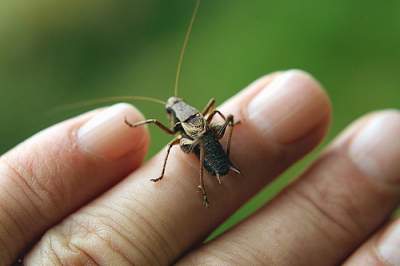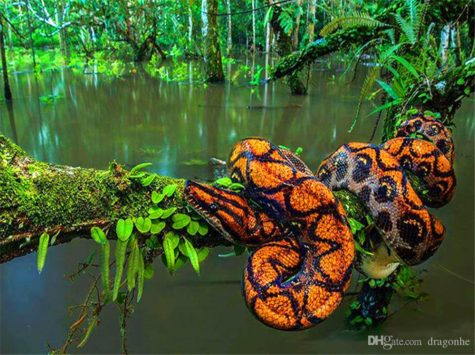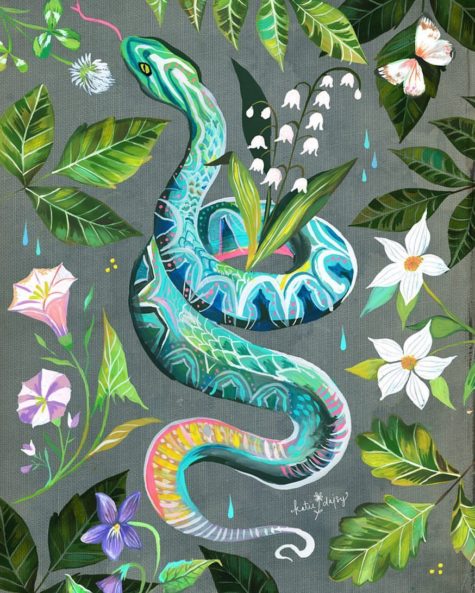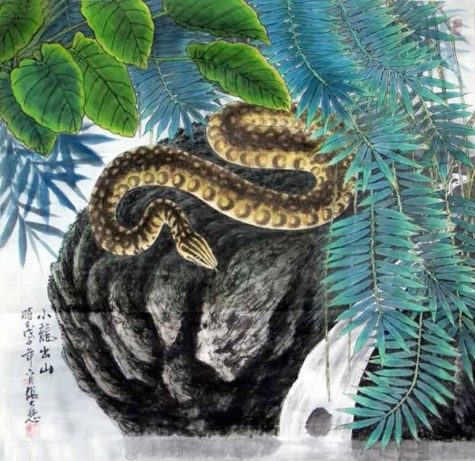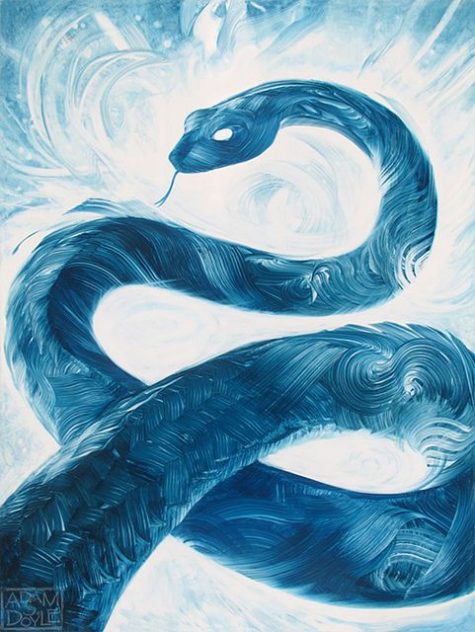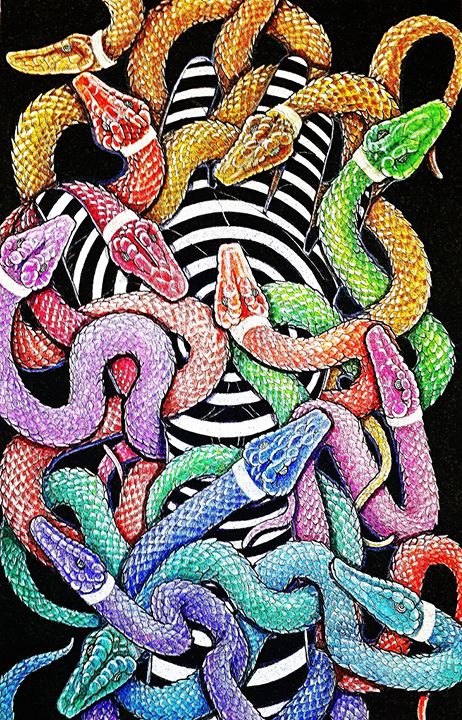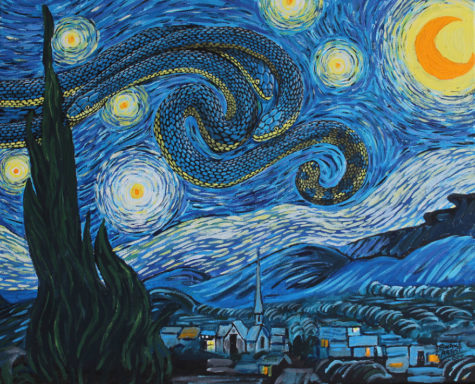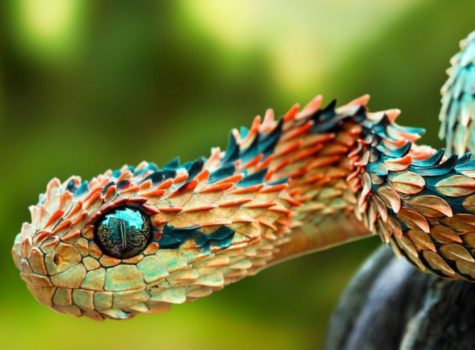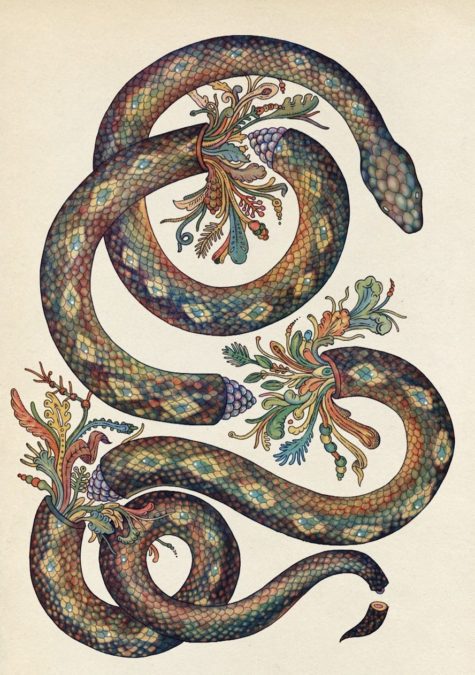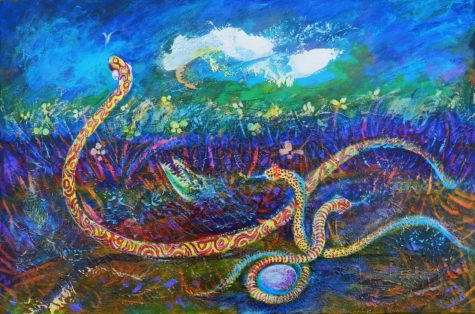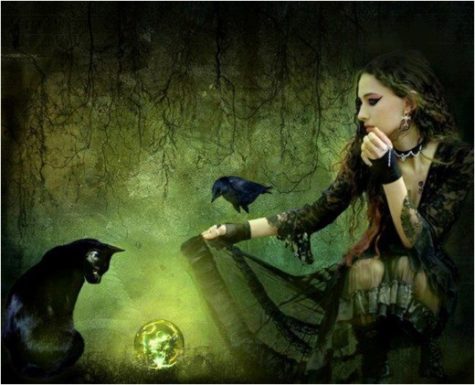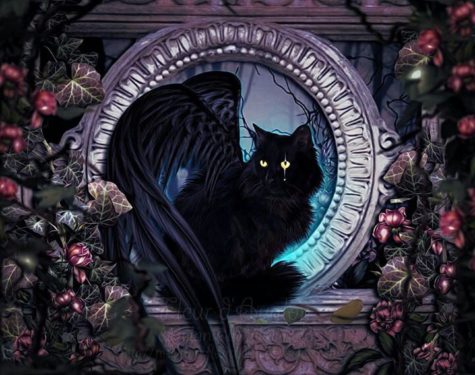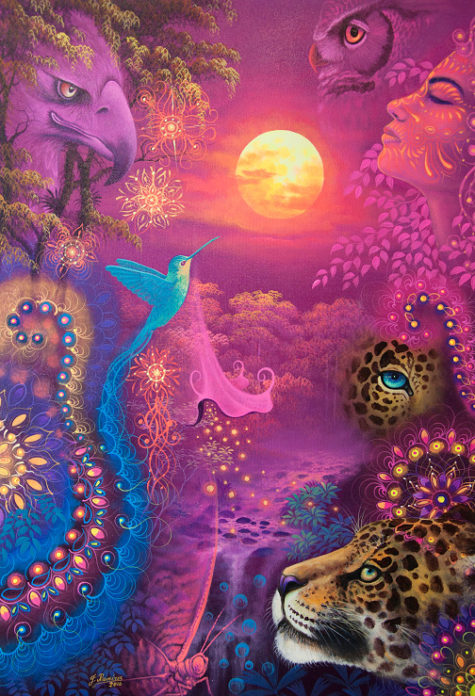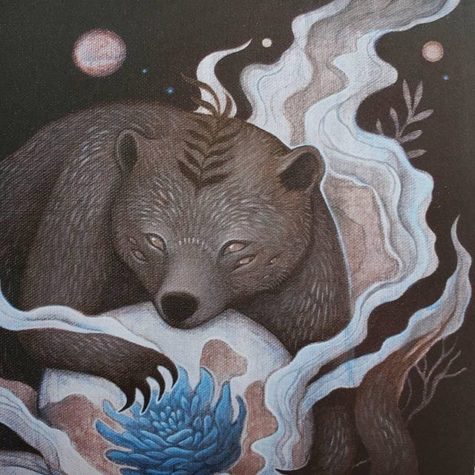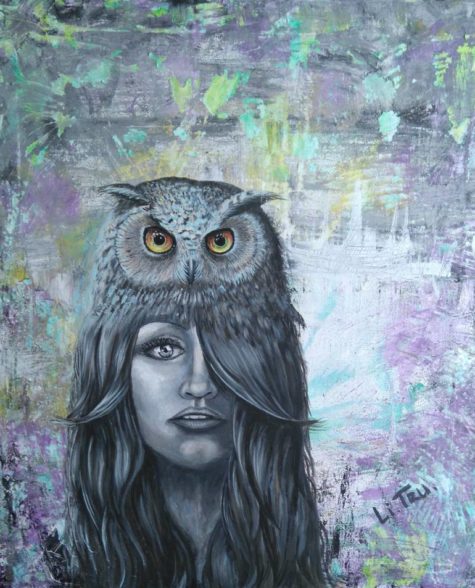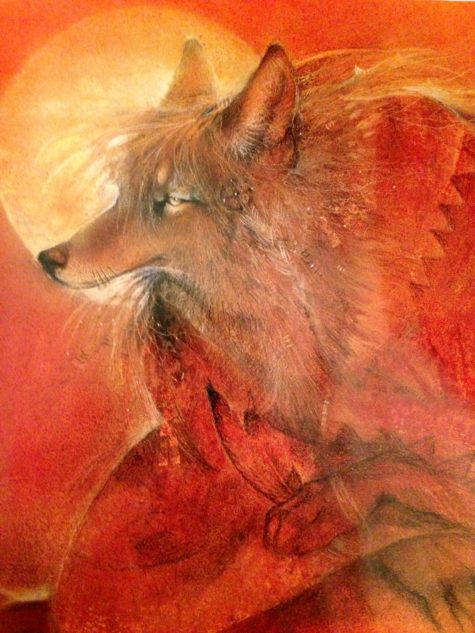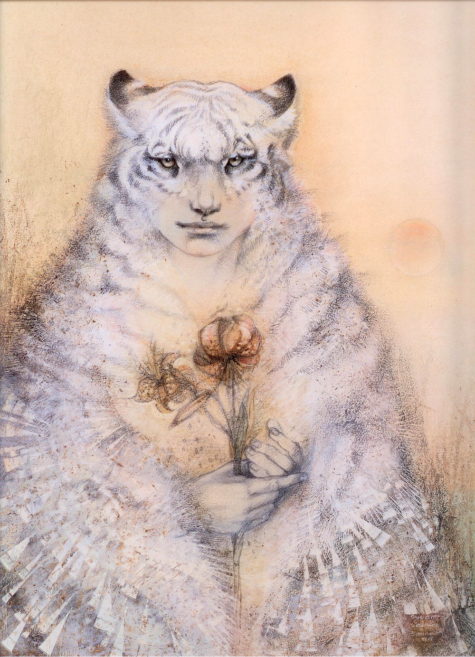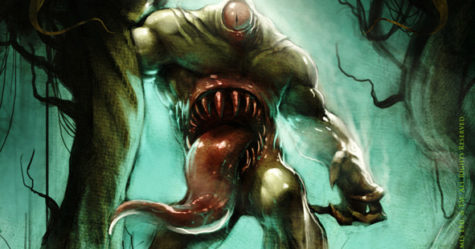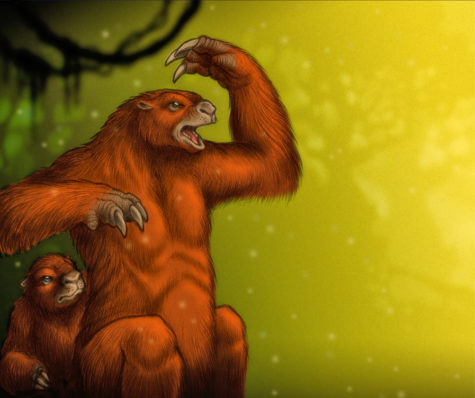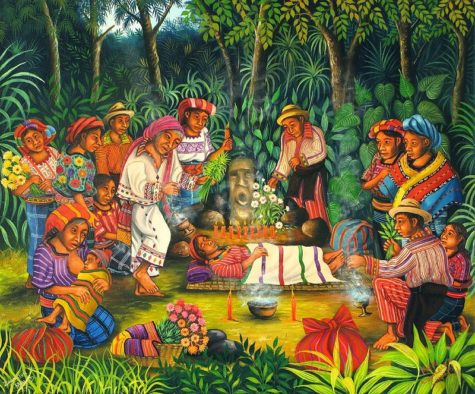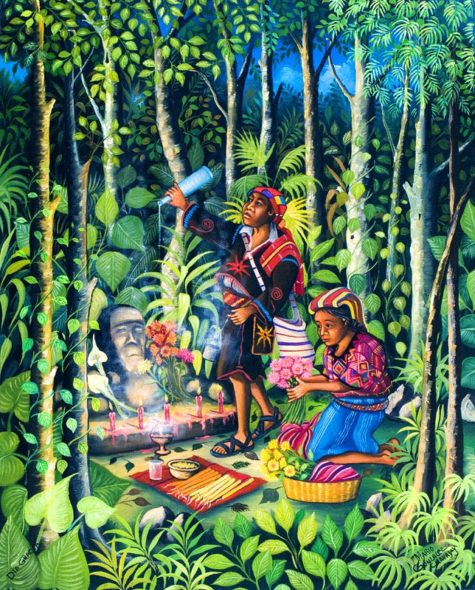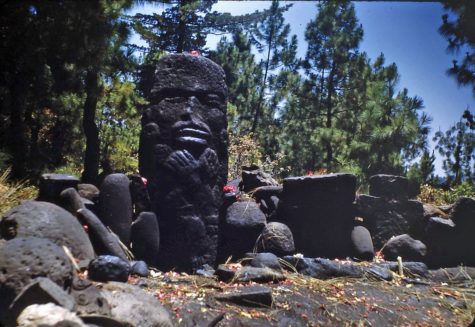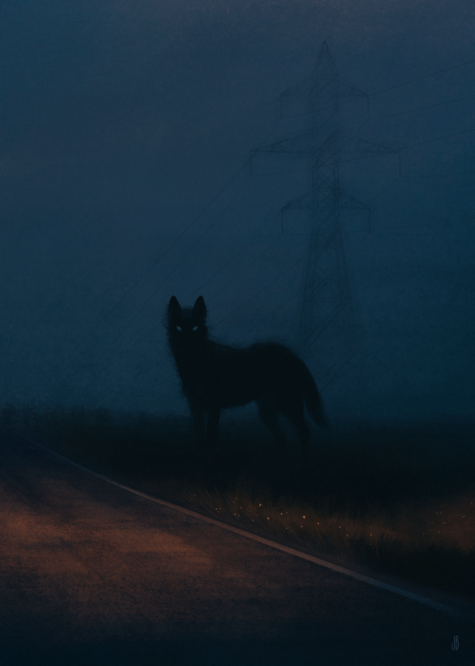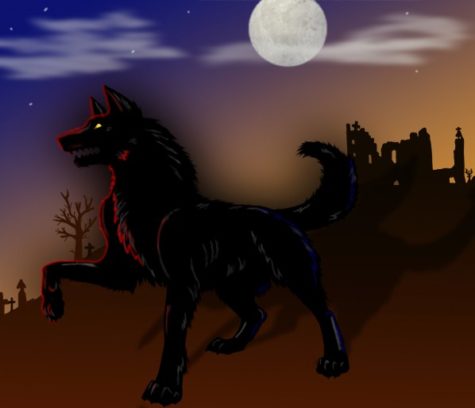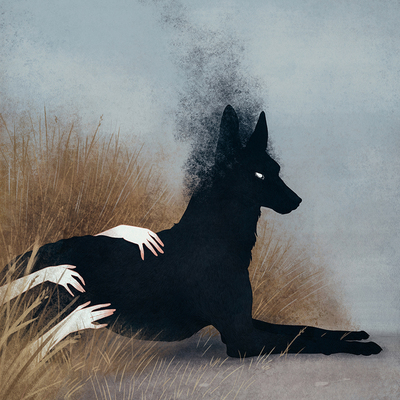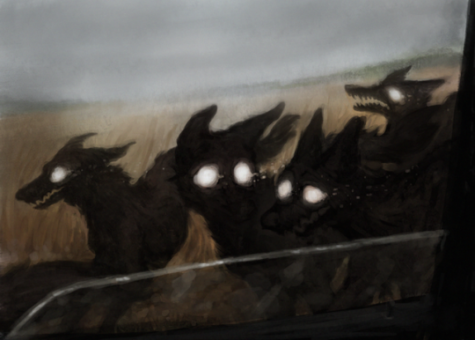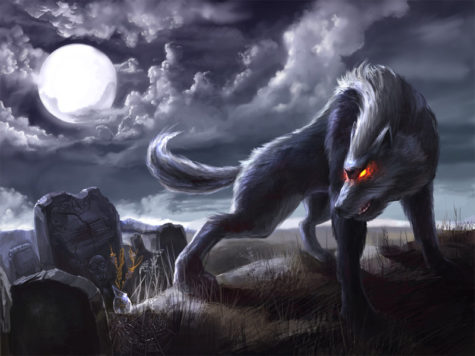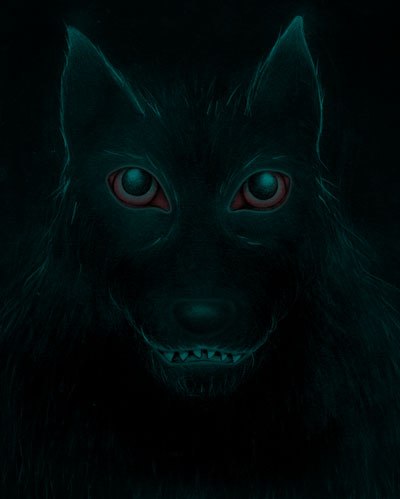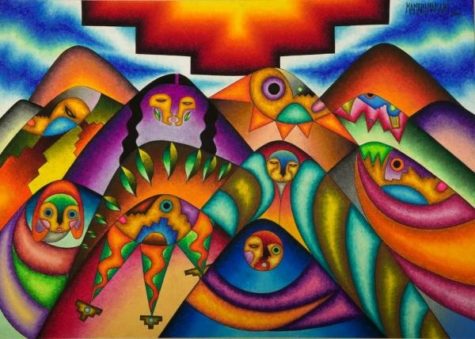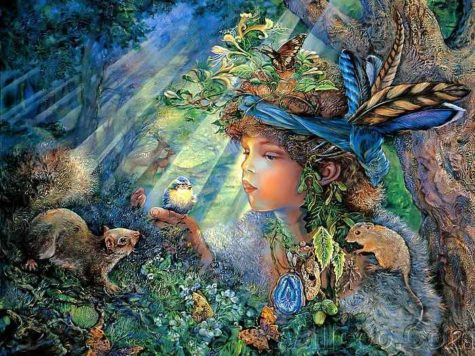Guardians
“I do believe that an intimacy with the world of crickets and their kind can be salutary – not for what they are likely to teach us about ourselves but because they remind us, if we will let them, that there are other voices, other rhythms, other strivings and fulfillments than our own.”
~Howard E. Evans
Cricket will attune to new vibrations and will aid in heightening intuition, sensitivity and awareness. Crickets can teach effective communication techniques and subconsciousness communication cues to obtain what is needed or wanted.
- Keynote: Sensitive intuition, Power of belief
- Most Powerful Time: Late summer and autumn
Crickets are about resurrection and transformation from stages as in the molting process. Is it time to shed old ideas to make way for the new? Expect changes and new developments that will bring growth through reflection and patience as the sensitivity to mental, emotional and physical challenges are coming your way.
- Are you singing your song to be heard at this time?
- Is it time to rest in contemplation or jump toward your intended target whether it be at work, in relationships, or personal goal and dream?
Cricket will help in finding the right balance of action using intuition and subtle awareness.
If A Cricket Shows Up
Crickets have an abundance of myth and folklore surrounding them, almost all having to do with a stimulation of intuition and the power of our beliefs. In China the cricket is considered a summer animal symbolizing pluck and a fighting spirit. In fact, ceremonial cricket fights were once staged to awaken such a spirit in their human captors.
In England and parts of Europe, to find a cricket upon one’s hearth was a sign of great good luck for the home Although some superstitions speak of a cricket in the home as a foreboding of death and bad luck, such teachings were rare. The opposite is the more common interpretation.
Crickets in the home were often thought of as the familiar that watched over and guarded the home’s occupants ~ especially against bad spirits. In the 1800’s many people believed that crickets were lucky to have about the house and would do no harm if treated well. Bad luck would befall only those who harmed this creature. In most traditions, it is best to leave the cricket alone. To remove it from the house or to kill it would bring bad luck.
The Cricket As A Guide
There are several thousand species of crickets around the world. They are also known as bushcrickets, and although they are related to the grasshopper, they have a distinct symbology. They have been kept as pets, many believing them to be the reincarnation of relatives. They have been considered a familiar by some and the devil by others. Their singing was believed in parts of Europe to herald good luck. To do them harm was unlucky, while to honor them brought good fortune.
While some species do sing in the day, most crickets are mainly nocturnal. The appearance of cricket in your life heralds an awakening of sensitivities and the finding of light within the dark. This is primarily because of their nocturnal activity and their darker coloration. They are perceptive within the dark times and are able to use whatever light is available to them.
Their appearance reminds us to trust our own intuition, as it is much more accurate than we may believe. Dreams will become more clairvoyant, and cricket reminds us that we can truly rely on our dreamtime perceptions.
Crickets are distinguished from grasshoppers primarily by their long antennae, which reflect our heightened sensitivity. They further remind us to trust our own intuition and our own expressions of light, even if different from others. Now is the time to believe in and rely upon our long range perceptions and insights. We should trust in what we have always believed.
The male cricket sings by rubbing its wing bases together. Their calls are often shrill, but it is a call that is connected to mating. The song of the cricket is a song of good cheer, especially in relationships, a reminder to trust in our beliefs and perceptions about the other people within our lives. If cricket is singing within your life, now is the time to be of good cheer. Your believing is about to be rewarded, and the song they are singing is of success and pleasures ahead.
Most crickets live on the ground. Some can fly, but many have no hind wings. Some have no wings at all. If cricket has appeared, we may need to stay balanced and grounded when exploring or working with our intuition and psychic abilities. Our belief system may be a bit askew. It is not unusual to find a cricket appearing at times for professionals in the psychic or metaphysical field when conscious efforts are not being made to be balanced and grounded.
Most crickets molt at least once, and a cricket may warn us that it is time to shed old beliefs that are no longer suitable. It can warn that the psychic energies of ourselves or others may be over-stimulated and exaggerated at this time.
- Are we not seeing things properly?
- Are we denying our own beliefs?
- Have we forgotten how to believe?
- Is it time to get some new beliefs?
- Are we exaggerating what we perceive?
- Are we not hearing the true songs of the people around us?
- Do we need to listen to what is not being said as much as to what is?
- Are we not holding true to our beliefs? Are others?
Beliefs and ideas are more likely to be distorted and embellished, and this should be taken into consideration before taking any action. Perceptions may lack depth and there may even be some deception about what is being perceived. Others may be trying to make us believe something that is not entirely true or to which there is incomplete information. The cricket should stimulate some self-examination.
Cricket Superstitions
Beliefs about crickets vary considerably. As a rule, these friendly little insects, which love to make their home with human beings, are thought to be fortunate. If they leave a house suddenly, after long dwelling therein, it is an omen of death, and to kill one brings sure misfortune.
On the other hand their chirping is sometimes regarded as a death omen or a sign of a coming storm. If they suddenly invade a house where none was before, bad luck is expected in some parts of the world.
For thousands of years, it has been considered lucky to have a cricket on the hearth, especially in Asian countries where crickets were once used as “watchdogs.” When danger approached, the cricket’s chirping would stop. The appearance of a white cricket on the hearth, however, is almost everywhere considered an extremely bad omen, foretelling a death in the family soon.
The chirping of crickets predicts changes in the weather, the arrival of friends, and changes in luck.
The cricket is known as “the poor man’s thermometer,” and is believed by some to be a good indication of the temperature. To know the temperature, count the number of chirps a cricket makes within’ fifteen seconds and add the number thirty-seven. This will give you the temperature in degrees. An alternative measurement calls for counting the number of chirps in 15 seconds and then adding 40 to it.
In East India the superstition of the cricket lies in the story of the peril of the soul which, it is held, can leave the body during sleep. The soul, says this Indian fable, leaves the sleeping person in the form of a cricket emerging from the nose.
Native Americans believed crickets brought good luck as well, and avoided mimicking the chirping out of respect for the insect. At one time, it was said that Cherokee Indians drank tea made of crickets, in order to become good singers like the crickets.
It was generally believed that killing a cricket in your house would bring bad luck. It’s possible that this superstition of misfortune from killing a cricket comes from the idea that such an act is a breach of hospitality, the little insect invariably taking refuge in houses, and singing it’s cheerful “all is well” songs.
The singing of crickets in the folklore of Brazil and elsewhere is sometimes taken to be a sign of impending rain, or of a financial windfall. In Álvar Núñez Cabeza de Vaca’s chronicles of the Spanish conquest of the Americas, the sudden chirping of a cricket heralded the sighting of land for his crew, just as their water supply had run out.
In Caraguatatuba, Brazil, a black cricket in a room is said to portend illness; a gray one, money; and a green one, hope. In Alagoas state, northeast Brazil, a cricket announces death, thus it is killed if it chirps in a house.
In Barbados, a loud cricket means money is coming in; hence, a cricket must not be killed or evicted if it chirps inside a house. However, another type of cricket that is less noisy forebodes illness or death.
More Cricket Superstitions:
- It was believed that a cricket can tell of oncoming rain, death, and x-lovers.
- It’s very bad luck to kill a cricket, even by accident.
- If you kill a cricket you will tear your drawers (underwear).
- If a cricket is caught in a deep crevice in the rock, or between boards, the bystander who does not release him will suffer from bad luck.
- If you kill a cricket other crickets will come and bite holes in your clothes.
- A cricket in the house brings good luck.
- Finding a cricket in your house tells of money on its way or some other prosperity coming. Make sure to not disturb the cricket.
- It is very bad luck to kill a cricket on a Sunday.
- A cricket is a lucky house spirit that takes it’s luck away when it leaves.
- The chirping of a cricket foretells sorrow.
- If a cricket chirps behind the stove, some one in the family must die. Others consider it an omen of good luck.
Celtic Cricket Lore
The crickets are believed to be enchanted. People do not like to express an exact opinion about them, so they are spoken of with great mystery and awe, and no one would venture to kill them for the whole world.
But they are by no means evil; on the contrary, the presence of the cricket is considered lucky, and their singing keeps away the fairies at night, who are always anxious, in their selfish way, to have the whole hearth left clear for themselves, that they may sit round the last embers of the fire, and drink the cup of milk left for them by the farmer’s wife, in peace and quietness.
The crickets are supposed to be hundreds of years old, and their talk, could we understand it, would no doubt be most interesting and instructive.
Chinese Cricket Lore
In early China, farmers used crickets as a symbol of the growing season. When crickets appeared each year, it was time to plant crops; when they disappeared in the autumn, it was time to harvest.
Crickets also are symbolic of success and family size in China. The insects lay hundreds of eggs before dying. Centuries ago, large families were very important to the Chinese, as they were equated with success. To wish someone to have a family like crickets was to wish them success.
The Chinese believe the crickets make not noise, but beautiful music. Songs have been written around the chirping sounds made by male crickets. The cricket also symbolizes summer as well as courage and a fighting spirit.
Even in the 21st century, the Chinese still revere crickets. They still buy them in little cages so they can take them home and listen to them sing. China’s major cities such as Beijing and Shanghai even have insect markets where crickets can be purchased. Cricket fighting is as popular today in China as it was centuries ago. Crickets perceived to be good fighters can sell for hundreds, maybe even thousands, of dollars.
Crickets As Pets and Fighting Animals
Crickets are kept as pets and are considered good luck in some countries; in China, they are sometimes kept in cages or in hollowed-out gourds specially created in novel shapes. The practice was common in Japan for thousands of years; it peaked in the 19th century, though crickets are still sold at pet shops. It is also common to have them as caged pets in some European countries, particularly in the Iberian Peninsula.
Cricket fighting is a traditional Chinese pastime that dates back to the Tang dynasty (618–907). Originally an indulgence of emperors, cricket fighting later became popular among commoners. The dominance and fighting ability of males does not depend on strength alone; it has been found that they become more aggressive after certain pre-fight experiences such as isolation, or when defending a refuge. Crickets forced to fly for a short while will afterwards fight for two to three times longer than they otherwise would.
Cricket in Slang and Metaphor
By the 19th century “cricket” and “crickets” were in use as euphemisms for using Christ as an interjection. The addition of “Jiminy” (a variation of “Gemini”), sometimes shortened to “Jimmy” created the expressions “Jiminy Cricket!” or “Jimmy Crickets!” as less blasphemous alternatives to exclaiming “Jesus Christ!”
By the end of the 20th century the sound of chirping crickets came to represent quietude in literature, theatre and film. From this sentiment arose expressions equating “crickets” with silence altogether, particularly when a group of assembled people makes no noise. These expressions have grown from the more descriptive, “so quiet that you can hear crickets,” to simply saying , “crickets” as shorthand for “complete silence.”
Sources:
- Ancient Legends, Mystic Charms, and Superstitions of Ireland
- Star Stuffs
- Animal Wise
- Wikipedia
- The Classroom
The Magnificent Snake Totem possesses the following virtues:
Wisdom, healing, intuition, awaking of creative forces, ability to handle change without resistance, new opportunities for change, material vitality, intellect, power over rashness in speech and thought, emotional control, increased sensitivity to the environment, increased powers of smell, transmutation, and increased powers of observation.
When Snakes enter into your world expect swift changes to sweep through your life. These changes signify a death of the old and a birth into untapped power, creativity and wisdom. Snake is a powerful totem to have. Only those with a high degree of spiritual training, be it past or present, will be awarded this totem. It is the guardian of sacred places and the keeper of hidden knowledge.
Snake Symbolism
The snake is a symbol of transformation and healing. Anytime a snake shows up as a totem, you can expect death and rebirth to occur in some area of your life. This rarely reflects an actual death but rather a transition. Look for change in conditions and a movement to new life. Examine what is going on around you:
- Are you needing to make changes but aren’t for some reason?
- Are you trying to force change too quickly?
- Are you striking out at people and shouldn’t?
- Are you not striking and should?
- What is needing to be healed?
- What new opportunities are surfacing that you need to strike out for and take advantage of?
- When you are frightened, how do you bluff?
- Do you exaggerate your fears?
- Do you want to appear bigger or more important than you really are?
- Are you bluffing?
It can also reflect that your own creative forces are awakening. Spiritually, it can stimulate greater perception of how to apply your insight and intuition. Your own vision and intuition will become more accurate. Learning opportunities, formal and informal, will surface frequently. You will be able to swallow and digest whatever you take in.
Snakes have speed and agility, so those who have snakes come into their life will usually find the changes and shifts occur quickly and are soon recognized and defined. When snake comes into your life you can look for a rebirth into new powers of creativity and wisdom.
Snake Lore
The snake dwells in so many places, climates and environments, comes in so many colors, shapes and sizes that this creature can be said to be one of the most versatile of all. Indeed snakes represent versatility, transmutation and change, their natural inclination to “shed their skins” leaving behind the old, and adapting to the new, supports this idea.
The snake has been, throughout the ages, controversial in many regards. Some see the snake as a bearer of evil or bad news, but most see the snake as the healer and spiritual icon that it is. Like any creature, human or animal, they possess both noble and questionable qualities. Some people fear them and many more are charmed by them.
Most of us recognize the snake as the symbol of physicians and alchemists, which shows two snakes wrapped around a staff. This again, supports their totem reputation as healer. Snakes are highly respected in India and their lore and symbolism is highly regarded by their culture; Vitana, the mother of snakes, is the symbol of water and the underworld and the Goddess Shiva always wears snakes on her body as jewelry, which represents sexuality. Native Indians also see the snake as a representation of fertility and healing.
Those who are said to posses Snake like qualities have control over their emotions, excellent intuition and the ability to heal quickly. They are slow to anger but have enormous coiled power within them and will strike with control and precision when they must. Some snake type people, like their reptile counterparts, will give their opponent fair warning before striking, others will attack powerfully and without any warning. Snakes rarely, if ever, attack unless provoked, which is an excellent lesson for all of us to learn. Others should be on their guard when in snake territory and should respect the snake’s province.
Snakes awaken spiritual and magical intuition in the person who chooses this totem or is chosen by it. Snakes are associated with unseen creative forces at work. With the snake totem the powers of intuition and observation becomes keener and more precise. As snakes represent change and intuition the combination of these characteristics will allow for great new developments in life and the proper instinct for deciding which changes will be effective and which should not be made. They represent openness to new experiences, and thus, opened horizons.
The Snake in the wild is generally clam and peaceful. They hunt for food when hungry and can go long periods of time without eating again. They bask on warm rocks and will usually not attack unless prompted. To annoy or provoke a snake is a very unwise mistake, which many people make. Because of their calm and somewhat shy nature, many believe that they are too still or quiet to be much harm, however, as many have discovered, while a snake may seem as though it is still and unaware, if pressed they can and will deliver a dangerous blow or bite, sometimes without warning, that can leave permanent damage or even cause death to its victim.
Snakes are very sensitive to their environment, they are silent, calm creatures and seem to be very serene on the outside, but within this animal is coiled power that can deliver lethal blows, with well timed and startling accuracy. The snake is a powerful totem, symbolizing eternity, wisdom, transformation and intuition. Their wisdom is expressed as healer and the snake has been used as a symbol of this for centuries.
More Snake Lore
Snakes are fascinating creatures that deserve respect. Throughout history the snake has had many legends associated with it linking them to creation, fertility and transformation.
In Israel the snake was regarded as the earth mother and played a beneficial role in fertility. In Egypt the cobra was known for its ability to expand the upper neck into a disc shape by spreading its ribs which symbolized immortality. In Christian lore the snake is seen rising from the chalice of St. John wound around a cross sometimes portrayed with a woman’s head to symbolize lust and temptation. In Eastern cultures a snake rising up through the spine represents the kundalini, or life force being awakened.
One of snakes most noticeable characteristics is the regular shedding of its outer skin as it grows. Once the skin is shed, the old inner layer becomes the new outer layer and a new inner layer of skin begins to develop. Crawling out of its old skin is very significant for those with this medicine. It is a metaphor for how we shed old ways and habits as we grow into higher spiritual energy symbolizing the death and rebirth process. It is also associated with astral travel and out of body experiences.
The eyes of a snake are always open protected by immobile transparent scales. Prior to shedding its skin the snakes markings become obscure and the eyes appear opaque or blue. This gives it a trance like appearance as if it is looking right through you. Learning how to see into the hearts of others is part of what it teaches us.
Snake has been a symbol of life and sexuality for thousands of years in many cultures. It is a totem of power, renewal and transmutation. Soundless in motion and invisible at rest snakes are unable to produce their own body heat. They are often seen lying in the hot mid day sun. The suns warmth coupled with the snakes behavior regulates their body temperature. Not relying on the energy of food to generate body heat, they can survive on meager diets for extended periods of time. Those with this totem need very little food to energize themselves. They are usually cold and prefer warmer climates. Their body temperatures are often lower than normal.
Snakes lack eardrums and external ear openings but have small bones in the head that conduct sound. They are able to hear low frequency sounds and sense vibrations that travel through the earth. This links them to the underworld where secrets are stored. The snake symbolizes healing on a cellular level. Because their bodies are lightweight and flexible they have speed and agility.
Snake Beckoning Spells
The snake is the totem animal of prophets, so it’s no accident that the staffs of Asklepios, Hermes, and Moses were embellished with snakes. Over the centuries, magical divining women, from the Minoan snake goddess to Marie Laveau, have danced with serpents. There is even a traditional divination system that interprets the movements of snakes.
Because snakes are the repository of Earth’s wisdom, there are may reasons why one would wish to communicate with them. Snakes are among people’s primary magical teachers and are invoked in spells for childbirth, fertility, healing, protection and financial well-being.
That said, it may be easier for most people, for a variety of reasons, to access that knowledge through visions rather than actual contact.
The scent of lavender allegedly invokes the spiritual presence of serpents and the legendary Serpent Spirits. Here’s how to use it:
Place an image on an altar, either of a snake or of an affiliated deity – the Minoan Serpent Goddess for instance. Surround this with fresh lavender or warm the essential oil in an aroma burner. Call the spirit. Be prepared to explain why you have issued the invitation.
Do this spell before bedtime, to receive a visitation in your dreams.
Alternatively, you can burn yarrow. Yarrow smoke allegedly stimulates visions of shakes. Burn yarrow and allow the smoke to permeate the area. Have your questions or goals ready.
Dreaming Snakes – What does it mean?
Gillian Holloway, Ph.D. identifies being bitten by a snake as meaning different things. She says, “In many dreams a single snake will come to bite you, and you may in fact be bitten after a brief struggle. To your amazement though, you will not die, and may find that the situation is not as bad as you thought.”
According to Holloway you have this kind of dream if you are struggling with some problem, relationship or challenge. “Such a snake-ordeal is an important signal that you are going through a kind of initiation; a psychological and spiritual trial that has the potential to change your life for the better if you deal with it bravely and with a clear heart. You may have to give up something you thought you couldn’t, or take a stand for your principles or faith.”
- Other interpretations:
When one is bitten by a snake in a dream, this often actually points to overcoming a situation that appeared dire. The a snake bit dream may point to learning to overcome a situation and regain your power in life. Snake bites can be viewed as in injection of wisdom, rather than life threatening venom.
The Lotuko-speaking Lango of Africa believe that to dream that a snake bites you is a very bad omen. Immediately on waking you should bite a piece of charcoal and spit it out and then prick yourself with a thorn. This will avert the omen and even if you meet a snake, as you surely will, it will not bite you.
- An historical perspective:
In some cultures snakes are highly regarded and symbolize the ability to transcend into higher levels of consciousness or into areas of knowledge that exist outside perceived time and space. In the pre-Christian days, snakes were considered symbols of fertility, healing, and nurturing (the healing serpent representing a god). Post Adam and Eve, snakes are often considered symbols of temptation and evil, anger, and envy. Snakes emerging out of the ground may represent your unconscious or repressed materials coming to your conscious mind. Freud thought that the snake was a phallic symbol.
- You are not alone:
It is amazing how many people have snake dreams! Most snake dreams seem to be disturbing and they leave the dreamer feeling anxious and afraid. There are no simple interpretations to the snake dreams. Each dreamer must consider their own situation and all of the details of the dream. Sometimes snakes may be phallic symbols and other times they represent negativity in our lives that hampers our progress and constantly threatens us.
In the long run the snake may be a positive symbol; it may represent difficulties that lead us to the center of personality and result in feelings of completeness.
Is That Snake Poisonous?
Snakes that are members of the pit viper family are easy to distinguish:
- Identifying a poisonous snake by its pupils.
Harmless snakes have round pupils (the black part in the center of the eye). Poisonous snakes have egg-shaped or cat-like (elliptical) pupils. In good light, you easily can see the pupil shape from a safe distance because snakes cannot jump, nor can they strike, from more than one-third of their body length.
Poisonous snakes also have a conspicuous sensory area or pit (hence the name “pit viper”) on each side of the head. The pit looks somewhat like a nostril and helps the snake locate warm-bodied food. It is located about midway between and slightly below the eye and nostril. Harmless snakes do not have pits.
- Identifying a poisonous snake by its tail.
The underside scales of a poisonous snake’s tail go all the way across in a single row from the anal plate. The tip of the tail may have two scale rows. Nonpoisonous snakes have two rows of scales from the vent to the end of the tail. This characteristic also can be seen on skins that may have been shed.
- Other features may help you identify a poisonous snake at a distance:
Usually, poisonous snakes have a triangular (wide at the back and attached to a narrow neck) or “spade-shaped” head. Be aware that many other harmless snakes flatten their heads when threatened and may appear poisonous.
Usually, rattlesnakes sound a warning rattle (a buzz or a dry, whirring sound) when approached. However, many nonpoisonous snakes (black racers, corn snakes, rat snakes, milk snakes and pine snakes) and several poisonous snakes (copperhead and cottonmouth) often vibrate their tails when threatened. The sound produced by this vibration often imitates a rattle or hissing sound when the snake is sitting in dry grass or leaves.
Snakes with lengthwise-striped markings are nonpoisonous. Most solid-colored snakes also are nonpoisonous, except the adult western cottonmouth, which has dark crossbands that often are indistinct. If a snake is marked in any other way, use other characteristics for identification.
You easily can recognize young cottonmouths and copperheads by their bright yellow or greenish yellow tails.
Don’t Do This!
While researching snakes, I came across this nifty little tidbit. It’s a list of what not to do when it comes to snakes.
A. Don’t cross a snake’s path unless you slide or shuffle your feet.
B. You’ll have leg aches – other diseases – bad luck.
A. Don’t eat in front of a snake.
B. When you get older, your throat will close.
A. Don’t watch a snake swallow it’s food.
B. Your neck will swell up.
A. Don’t watch a water snake swallow.
B. You’ll lose your voice.
A. Don’t open your mouth when you see a snake.
B. He’ll jump in.
A. Don’t kill snakes or lizards.
B. It will make your heart small – dry up – you will get a crooked back.
A. Don’t burn a snake.
B. You’ll get sores – rash.
A. Don’t kill a snake when it is raining.
B. Lightning will strike your house.
A. Don’t put a snake in the open when dead.
B. The lighting will bring it back to life.
A. Don’t put a dead snake on a rock.
B. You’ll cause a thunderstorm – it will come back to life.
A. Don’t kill a snake with your hand.
B. Your hand will swell up.
A. Don’t go to the bathroom in front of a snake.
B. He will be jealous of your wife and turn her yellow.
A. Don’t pick up things between two fingers.
B. Only snakes do that.
A. Don’t watch snakes having intercourse.
B. You’ll go blind.
A. Don’t step on a snake.
B. Your legs will swell up – get crooked.
A. Don’t draw in the sand with your fingers.
B. Snakes will come to it.
A. Don’t talk about snakes.
B. They will come around.
A. Don’t laugh at a snake.
B. It will bite you.
A. Don’t make faces at a snake.
B. It will bite you some day.
A. Don’t spit at a snake.
B. It will get after you.
A. Don’t watch a snake crawl out of its skin.
B. You’ll get sick or jump out of your skin.
A. Don’t shoot an arrow at a snake.
B. It will go crooked – hit something else – be spoiled.
A. Don’t run over a snake in your car.
B. You’ll have a bad life.
A. Don’t break snake eggs.
B. The snakes will get you.
A. Don’t wear anything made out of snakeskin, especially boots or shoes.
B. You will get crippled.
A. Don’t touch a snake.
B. It has nothing and it will make you have nothing.
A. Don’t call a person a snake.
B. You’ll be bitten by one.
A. Don’t urinate on roads that cross each other.
B. That is the same as a snake trail
More Navajo snake taboos can be found here: Navajo Snake Superstitions.
Sources:
- Mani Zone
- Animal Speak
- Navajo Taboos; Ernie Bulow, 1991
- University of Missouri Extension Center
- The Element Encyclopedia of 5000 Spells
The concept of the familiar has been a vital component of various cultures throughout man’s history. The Romans, for example, believed that each household was protected by a familiar whose job it was to keep the family from harm, and shamans and medicine men of various tribal traditions have long honored the spirits of animals for their wisdom and assistance in magickal workings.
Yet despite these positive influences, when we think of a familiar the most common image is that of the evil witch with her fearsome-looking black cat. This archetype, straight from the fairytales of our childhood, has its roots in the fear and superstition of the Dark Ages, and it bears no resemblance to the modern-day familiar.
Today’s witches view their familiars in an altogether different light. For the modern witch, a familiar can be any animal with which the individual feels an affinity. While these animals are not considered evil spirits, they’re far from being just a household pet and are treated as partners in the practice of magick.
Because animals are believed to be more sensitive to vibrations from the unseen world, they are useful to the witch as a kind of psychic sensor, indicating the presence of negative energy by their behavior. Familiars also bring added energy to magickal workings because of their close affinity with the spirit world and their attunement with their witch.
The finding of an animal familiar is a very personal thing, and often the witch will send out a psychic call to attract a suitable one. An immediate and overwhelming feeling of kinship between the witch and the animal usually signifies the discovery of the new familiar.
In some cases familiars are not confined to physical bodies. Although they play the same role as animal familiars, spirit familiars are more versatile in that they can move about more freely. The presence of these sprit familiars is often experienced as a voice, vision, or strong feeling of peace. If necessary, they can be associated with inanimate objects, such as a stone or piece of jewelry, to make contacting the spirit an easy task.
Creating A Familiar
This rite it designed specifically for cats, but may be employed with any animal you wish to make your familiar spirit.
Each night during the cycle of the waxing Moon, sit closely with the animal. Arrange it so that you are both facing toward the horizon where the Moon shall rise. Stroke the creature firmly, but with love, until he or she begins to purr or relax. Align your own breathing with the purr, or in the case of a creature other than feline friend, align your breathing with that of the animal.
Continue to do this each night at moonrise. When the Moon is at full, your will shall be as one with that of your familiar. You shall see through its eyes, and it will see through yours. Your thoughts shall be as one, and you will share a single heart.
Source: M. Williams
Think about animals to whom you’ve always been attracted – and remember that “animal” includes birds, reptiles, amphibians, fish, insects.
- Do you collect owls?
- Draw pictures of dragons?
- Live for the sight of horses?
Swear that you would never want to live without a cat? (I believe that Cat is one of the most popular (and certainly one of the most accessible) power animals, closely followed by Dolphin and Wolf.)
- What animal do you feel is most like you?
- If you could be an animal what would you most want to be?
- What would you least want to be?
- Are there animals you dream about regularly?
If none of the above questions produce any inspiration, or if what you come up with doesn’t feel quite right be open to and affirm that your power animal(s) (there may well be more than one) will show themselves to you soon.
- Before you go to sleep each night ask for your power animal to appear.
- Make the same request while in meditation.
- Be aware of the animal images you see in the course of the day.
- Someone sent you a card with a picture of a wolf? There’s a special on the wolves in Yellowstone National Park on TV? This may be worth investigating.
- If you live in an area where wildlife abounds see who the most frequent visitors are.
- Which birds come most often to your feeder?
- Take out books on animals, preferably with pictures, from the library, and see whether any of them stir feelings within you.
You can also choose power animals based on qualities you would like to have in your life. For a listing of animals and their qualities, you can visit these posts: Animal Symbols in Magick and Animal Symbols and Archetypes.
Above all, be patient. You may be just opening up to the idea that animals have something to teach you. Your relationship with one will flower in its time, and you may find as you grow and evolve that your power animals change.
Meditation To Meet Your Power Animal
This guided imagery is about meeting your power animal. Like the ancient ones, the power animals come from deep within the consciousness of our Earth Mother. Power animals are our deepest memories. We all share DNA with all the animals alive on earth. A lion has the same DNA as we do for many systems. We can, in our memories, see out of the lion’s eyes. We are them. They call to us deeply, loudly.
Power animals are easier to contact than ancient ones. Their voices are louder. They are easier to see. They will come and speak to you when you need them. The animals are helpers. Like ancient ones they are guides. They tell you what you need to know. They give you their immense energy. No shaman would ever go into sacred space without their animal helper.
Read the following meditation a number of times, and then take the journey from memory. Alternatively, you could record it and play it back.
Close your eyes, take a couple of deep breaths, let your abdomen rise and fall. Allow yourself to become really relaxed. Think about a place, real or imagined, where you feel really safe, where you feel deeply connected with the earth. Now put yourself on a path. Feel your feet touch the earth, smell the fresh air, feel the warm breeze on your face. Walk down the path. It goes downhill slightly. The ground is hard and has small stones in the soil. It is solid and secure. Feel the ground and the grass that is on each side of the path. Walk down the path. It crosses a wooden bridge across a rushing stream. The bridge has stout railings. You can hear your feet echo on the bridge like a drumbeat as you walk across. If you need to drop something in the water that you want to get rid, of you can do that now.
The path now goes upwards slightly and comes over a rise. Below you is a large meadow. In the center of the meadow is a grassy circle. Sit in the circle and wait. Now ask for your power animal to come to you.
It might come from a distance or appear from nowhere. Whatever animal appears to you is your animal helper. It is your power animal. Allow the animal come towards you. Watch how it moves, listen to it speak.
You can stay in the meadow as long as you like to and feel connected to the earth. Your power animal is part of the earth. It has tendrils that reach deep into the earth, the sky, and you, and connect it all together. If you feel comfortable, you can invite your animal to come to you, touch you, even come into your body. You can merge with them and see out of their eyes.
When you feel complete, stand up and leave the meadow. The path goes out of the far side and you can walk down the path further. It leads to the edge of an ancient forest of old growth trees. Stand at the edge of the forest by a great ancient tree.
Find a tree that speaks to you and tells you to come to it. Now put your hand on the tree touch its rough back. Feel its warmth, it life. Now imagine that when you put your hand on the tree, you spiral deep into the spiral of your own being. You spiral deep inside yourself, into your heart. And inside your body, your heart opens with wings. A spirit eye opens within you and sees this experience.
Walk back to the meadow, then to the bridge, retrace your steps until you are back to where you started. Bring your spirit animal with you. Bring the connectedness with you. Now move your feet, your hands, your body. Look around. Your life has changed.
A Simple Shapeshifting Exercise
Here is an exercise in trading places (mentally) with a dog, a cat, or other animal. Once you become adept at this exercise, you will find animal communication, animal healing, and contact with power animals and guides much easier to accomplish.
- Setting: Home, Zoo, Wilderness, etc.
Instructions:
Relax your body as completely as you can. Calm your mind, eliminating all thoughts which do not relate to your intent and purpose. Sit so that you are comfortable, and as nearly as possible on the same level with the animal you will be working with. Lie down if you like. The important thing is that you are able to comfortably make eye contact with your animal partner in this exercise. It is also important to satisfy yourself that the animal is likewise comfortable and secure with you.
Take a deep breath. As you slowly exhale, look into the animal’s eyes, and imagine that a part of your awareness is being transmitted through your breath into the animal’s mind. Watch the animal breathe, and imagine that a part of its awareness is being transmitted into your mind.
Continue looking directly into the animal’s eyes until you fell your consciousness merge with the animal’s consciousness.
What to expect:
- You may begin to feel compassion for another species.
- You’ll also probably recognize some of the artificial differences between the human and animal worlds.
- You may be able to feel or sense the actual flow of the animals emotions and mental imagery.
As the boundaries between you and the animal dissolve, you may feel as if you’ve really traded places with a member of another species, as though a part of you has become the animal – this is the height of subjective merging.
Should you accomplish this, then it should be no trouble for you to contract with the animal to serve as your magical partner or “familiar.”
NOTE:
Asking another to become such a partner also places upon you the responsibility of becoming its partner. I would not recommend contracting an animal to become your familiar and then treating the animal as a pet. A pet is something you possess, own. A familiar, is an individual who has entered into a mutually beneficial relationship (partnership) with you, and therefore should be afforded the respect and consideration due a partner.
Sources: Unknown
The animal kingdom is very important to those who immerse themselves in natural magick. Sometimes you may want to communicate with animals or simply see the world through their eyes. A simple spell for merging your mind with animals is as follows:
Center yourself by sitting or lying upon the ground, closing your eyes, and imagine a whirlpool of energy surrounding you, travelling in clockwise motion from your head down to your feet, back up to your head, and back down to your feet. Continue this imagery until you feel grounded and centered, oblivious to daily distractions and cares. Once centered, allow your mind to wander to the animal you wish to merge with. Don’t force the imagery, rather allow it to happen.
Picture the animal clearly in your mind. Watch it, empathize with it, feel yourself merging with it. Imagine what it is like to be the animal. Imagine the sights it sees, the smells it senses, the motivations and ways of thinking it may have. Become those thoughts. Merge with the animal by dissolving the distinctions that make it separate.
Once you have fully merged with the animal, you can communicate with it. Ask it what you want to know. Tell it what you want it to know
Source: simplemagick.com
The mapinguari (“roaring animal” or “fetid beast”) is basically the bigfoot of South America. This roaring beast wanders the forests of South America, tearing down brush and trees with its powerful claws and leaving behind a trail of destruction as it looks for food.
According to native folklore the creature has a series of unnatural characteristics related to other fantastic beings of Brazilian mythology. These include the creature only having one eye, long claws, lizard-like skin, backward feet, and a second mouth on its belly. In more recent alleged eyewitness accounts, it has consistently been described as resembling either an ape or giant ground-dwelling sloth and having long arms, powerful claws that could tear apart small trees, a sloping back, reaching heights of 7 feet when standing on its hind legs, and covered in thick, matted fur.
This cryptid is described as a giant smelly beast that can stand on its feet like a grizzly, having the face of a monkey and thick fur over skin tough enough to stop a shotgun round in its tracks. Some sources have reported it sporting a second mouth in the middle of its belly, which emits a disgusting odor that leaves men dizzy, confused, and unconscious.
According to legend, it is slow but ferocious and very dangerous due to its ability to move without noise in the thick vegetation, surprising the unsuspecting locals. Accounts state that it gave off a putrid stench and emitted a frightening shriek, and that weapons such as arrows and bullets could not penetrate the Mapinguari’s alligator-like hide.
Its only known weakness is that it avoids bodies of water, which limits its movements in a region where so many rivers, brooklets and lagoons exist (especially during the rainy season). It was believed to be carnivorous, as a 1937 report from central Brazil claimed a mapinguari had gone on a three-week rampage, killing over 100 cows and ripping out the tongues from their carcasses. However, in all accounts it did not eat humans, although when it smells the presence of people it stands up on its back feet, becoming as tall as two metres, a movement similar to grizzly bears.
Often, people say the mapinguari serves as a sort of jungle protector, attacking those who take more resources than necessary. In this sense, it is similar to other legendary protector/punisher figures, like the boitatá and the curupira, a creature with backward feet who finds joy in confusing hunters.
According to Brazilian stories, the Mapinguari was once an Amazonian shaman who discovered the key to immortality thousands of years ago. He angered the gods and was severely punished as to his discovery, which forced him to be transformed into a wandering beast for the rest of his life.
Most sightings show the beast as a giant sloth, although a few see it as an ape-like creature. Most cryptozoologists speculate that the Mapinguari is either a Megatherium, a large giant ground sloth from the Ice Age that lived in the area, or another species of Giant Sloth.
There are accounts of this sort of creature that span tribal groups who have no contact with each other, and many similar stories from hunters, rubber tappers, and more. The ubiquity and consistency of these reports piqued the interest of some scientists. One, an ornithologist named Dr. David Oren, has arranged expeditions to search for the mapinguari, but so far has collected zero sightings and a bunch of hair and feces that turned out to be be the deposits of giant anteaters and the hair of small rodents.
One member of the Machiguenga tribe in Peru told another scientist, Dr. Glenn Shepard, that he had seen a mapinguari in a museum in Lima. That museum just so happens to include a display featuring a model of Megatherium.
Lucas Karitiana, a member of the Karitiana tribe in Brazil, insists his son encountered one in the forest, and, although he escaped unscathed, the whole surrounded area looked “as if a boulder had rolled through and knocked down all the trees and vines.”
Sources:
Just a few minutes walk from the church of Santo Tomás in the center of Chichicastenango, there is a wooded hill. Atop this hill is an ancient rock with a carved face, known all over Guatemala as Pascual Abaj (Sacrifice Stone). This stone-faced idol, a shrine to the Maya earth god Huyup Tak’ah (Mountain Plain), stands amid a circle of squat stone crosses in a clearing. Said to be hundreds – perhaps thousands – of years old, it has suffered numerous indignities at the hands of outsiders, but local people still revere it.
Daily there are Maya priests and priestesses performing ceremonies there. People come there for all sorts of things: to bless a marriage, to pray for a good harvest or to give thanks for a good harvest, or to remedy a problem such as preventing thieves from stealing your corn. The rites are conducted by the aj’itz (maya priests).
Also known as:
- Turcaj
- Turk’aj
- Turuk’aj
- Turukaj
Pascual Abaj (alternatively written Pascual Ab’aj) is a pre-Columbian Maya idol at Chichicastenango that survived the Spanish conquest of Guatemala and which is still venerated by the local community. It is the best-known example of such an image or shrine to the Maya earth god Huyup Tak’ah.
After the Spanish conquest, the stone figure is said to have been carried away from a site in the village of Chichicastenango and reset upon the hill so offerings could be made away from the vigilance of the Catholic Church and the Spanish colonists.
The image was badly damaged in the 1950s by members of Catholic Action. Before it was defaced, the statue was described as a grotesque human figure with a large head and high, pointed forehead. It had two circular earspools in line with its mouth; its arms were crossed on its chest, with the fingers extended. A cord was sculpted around its waist, to which was attached the image of an inverted severed human head. It stood approximately 1 metre (3.3 ft) high. An observer in the 1950s noted that the figure appeared to have been buried sometime in the past.
Traditional Maya shamans regularly perform ceremonies at the shrine, by day and night. The statue is set upon a small altar surrounded by offerings, which include pine branches, crosses, flowers, copal resin, and items crafted from stone. The shrine has now become a popular tourist attraction where visitors witness traditional Maya ceremonies.
Sources:
The Black Dog is among Britain’s most famous spectral hounds. It may be dangerous and malevolent or helpful and benevolent. It usually serves as a guardian of treasure or a sacred place. If left alone, it usually leaves you alone, too, but if aggression is shown toward it, the Black Dog isn’t afraid to demonstrate supernatural powers, potentially causing terrible wounds, paralysis, or death before vanishing into thin air.
- Manifestation: A shaggy black dog the size of a calf with glowing, red eyes.
- Other names: Moddey Dhoo, Mauthe Doog, Black Shuck, Old Shuck, Old Shock
This ghostly canine is also known as Mauthe Doog, a calf sized black dog who haunts Peel Castle on the Isle of Man. Guards saw the specter so often, they eventually grew less fearful. But, according to lore, one drunk soldier went down a passage in the castle to confront the ghost dog. He came back too terrified to speak and died three days later. The passage was sealed and never used again. Mauthe Doog sightings, however, continued.
Black Shuck
Black Shuck, Old Shuck, Old Shock or simply Shuck is the name given to a ghostly black dog which is said to roam the coastline and countryside of East Anglia, one of many ghostly black dogs recorded in folklore across the British Isles. Accounts of Black Shuck form part of the folklore of Norfolk, Suffolk, the Cambridgeshire fens and Essex, and descriptions of the creature’s appearance and nature vary considerably; it is sometimes recorded as an omen of death, but, in other instances, is described as companionable.
According to the Oxford English Dictionary, the name Shuck derives from the Old English word scucca – “devil, fiend”, from the root word skuh- to terrify. The first mention in print of “Black Shuck” is by Reverend E.S. Taylor in an 1850 edition of the journal Notes and Queries which describes “Shuck the Dog-fiend”;
“This phantom I have heard many persons in East Norfolk, and even Cambridgeshire, describe as having seen as a black shaggy dog, with fiery eyes and of immense size, and who visits churchyards at midnight.”
Images of black sinister dogs have become part of the iconography of the area and have appeared in popular culture. Writing in 1877, Walter Rye stated that Shuck was “the most curious of our local apparitions, as they are no doubt varieties of the same animal.”
Descriptions of Black Shuck vary in both shape and size, from that of a large dog to being the size of a calf or horse. W. A. Dutt, in his 1901 Highways & Byways in East Anglia describes the creature thus:
He takes the form of a huge black dog, and prowls along dark lanes and lonesome field footpaths, where, although his howling makes the hearer’s blood run cold, his footfalls make no sound. You may know him at once, should you see him, by his fiery eye; he has but one, and that, like the Cyclops’, is in the middle of his head. But such an encounter might bring you the worst of luck: it is even said that to meet him is to be warned that your death will occur before the end of the year.
So you will do well to shut your eyes if you hear him howling; shut them even if you are uncertain whether it is the dog fiend or the voice of the wind you hear. Should you never set eyes on our Norfolk Snarleyow you may perhaps doubt his existence, and, like other learned folks, tell us that his story is nothing but the old Scandinavian myth of the black hound of Odin, brought to us by the Vikings who long ago settled down on the Norfolk coast.
Dr Simon Sherwood suggests that the earliest surviving description of devilish black hounds is an account of an incident in the Peterborough Abbey recorded in the Peterborough Chronicle (one version of the Anglo-Saxon Chronicle) around 1127.
This account also appears to describe the Europe-wide phenomenon of a Wild Hunt.:
Let no-one be surprised at the truth of what we are about to relate, for it was common knowledge throughout the whole country that immediately after [Abbot Henry of Poitou’s arrival at Peterborough Abbey] – it was the Sunday when they sing Exurge Quare – many men both saw and heard a great number of huntsmen hunting.
The huntsmen were black, huge and hideous, and rode on black horses and on black he-goats and the hounds were jet black with eyes like saucers and horrible. This was seen in the very deer park of the town of Peterborough and in all the woods that stretch from that same town to Stamford, and in the night the monks heard them sounding and winding their horns.
Reliable witnesses who kept watch in the night declared that there might well have been as many as twenty or thirty of them winding their horns as near they could tell. This was seen and heard from the time of his arrival all through Lent and right up to Easter.”
Abraham Fleming’s account of the appearance of “A strange, and terrible wunder” in 1577 at Bungay, Suffolk is a famous account of the beast.
“A straunge, and terrible Wunder wrought very late in the parish church of Bongay: a town of no great distance from the citie of Norwich, namely the fourth of this August, in the yeere of our Lord 1577. in a great tempest of violent raine, lightning, and thunder, the like wherof hath been seldome seene. With the appeerance of an horrible shaped thing, sensibly perceiued of the people then and there assembled. Drawen into a plain method according to the written copye. by Abraham Fleming.”
One of the most notable reports of Black Shuck is of his appearance at the churches of Bungay and Blythburgh in Suffolk. On 4 August 1577, at Blythburgh, Black Shuck is said to have burst in through the doors of Holy Trinity Church to a clap of thunder. He ran up the nave, past a large congregation, killing a man and boy and causing the church steeple to collapse through the roof. As the dog left, he left scorch marks on the north door which can be seen at the church to this day.
The encounter on the same day at St Mary’s Church, Bungay was described in A Straunge and Terrible Wunder by Abraham Fleming in 1577:
This black dog, or the divel in such a linenesse (God hee knoweth al who worketh all,) running all along down the body of the church with great swiftnesse, and incredible haste, among the people, in a visible fourm and shape, passed between two persons, as they were kneeling uppon their knees, and occupied in prayer as it seemed, wrung the necks of them bothe at one instant clene backward, in somuch that even at a mome[n]t where they kneeled, they stra[n]gely dyed.
Fleming was a translator and editor for several printing houses in London, and therefore probably only published his account based on exaggerated oral accounts. Other local accounts attribute the event to the Devil (Fleming calls the animal “the Divel in such a likeness”). The scorch marks on the door are referred to by the locals as “the devil’s fingerprints”, and the event is remembered in this verse:
All down the church in midst of fire, the hellish monster flew, and, passing onward to the quire, he many people slew.
Dr David Waldron and Christopher Reeve suggest that a fierce electrical storm recorded by contemporary accounts on that date, coupled with the trauma of the ongoing Reformation, may have led to the accounts entering folklore.
Littleport, Cambridgeshire is home to two different legends of spectral black dogs, which have been linked to the Black Shuck folklore, but differ in significant aspects: local folklorist W.H. Barrett relates the story of a huge black dog haunting the area after being killed rescuing a local girl from a lustful friar in pre-reformation times, while fellow folklorist Enid Porter relates stories of a black dog haunting the A10 road after its owner drowned in the nearby River Great Ouse in the 1800s.
Sources:
In Inca mythology, Apu was the name given to powerful mountain spirits. The Incas also used Apu to refer to the sacred mountains themselves; each mountain had its own spirit, with the spirit going by the name of its mountain domain. An Apu is simultaneously:
- The sacred spirit of a mountain
- The mountain itself
- The spirit who lives atop the mountain.
Paradoxically, the Apu is inseparable from the mountain even though the spirit itself is completely mobile and perfectly capable of traveling far.
Apu literally means “lord.” Female Apus are address as “mama.” Apus were typically male spirits, although some female examples do exist. Female Apus include Mama Simona of Cuzco; Mama Patukusi of Machu Pichu; and Mama Veronica near Cuzco. Her Quechua name is Wakay Willca.
Every mountain peak in the Andes has its own Apu, but the most famous are the twelve associated with Cuzco:
- Apu Ausangate
- Apu Salkanaty
- Mama Simona
- Apu Pikol
- Apu Manuel Pinta
- Apu Wanakauri
- Apu Pachatusan
- Apu Pijchu
- Apu Saqsaywaman
- Apu Wiraqochan
- Apu Pukin
- Apu Senq’a
In the Quechua language—spoken by the Incas and now the second most common language in modern Peru—the plural of Apu is Apukuna.
Manifestation:
Apus frequently take the form of mischievous, playful, but helpful children. For instance, Apu Ausangate, considered the most powerful Apu of Cuzco, manifests as a blond, fair-skinned child wearing white clothes and riding a white horse. Don’t let their chosen form fool you ~ they are ancient and powerful spirits.
Gifts:
Small stones resembling animals or plants are sacred gifts from the Apus and may be used to bring whatever the stone resembles into your life. The resemblance may be enhanced by carving. These gifts are not limited to one person. They may be given to others or passed down through generations of a family. They may also be purchased at Andean pilgrimage sites. Modern versions of these amulets include miniature trucks, tools, and even passports.
Ritual and Offerings:
Travel to the Andes and visit the mountains to request their blessings and protection. Offerings include the following:
- Coca leaves
- Libations of water and alcoholic beverages
One of the most basic concepts of life in the high Andes communities is that of Ayni, or reciprocity, which connotes an ever-shifting, dynamic balance in relationship. This give and take informs not only connections that exist among people, but also the bonds between humans and the natural world, and most especially those between the people and the Apu.
The k’intu offering that reinforces this relationship has the Coca leaf as its main ingredient. Spiritual elders of the villages, or Misayoqs, say that the coca leaf is the favorite food of the Apus.
Three perfect coca leaves are infused with the breath of the Misayoq. This places his intention for the well being of the people into the offering. The k’intu is offered as a sacrament, to ensure his benevolent protection towards the people who dwell in his mighty presence.
An interesting account of an experience of talking with the Apu can be found here. It looks like they also offer trips to Peru, in case you are interested.
About The Inca Mountain Spirits
Inca mythology worked within three realms: Hanan Pacha (the upper realm), Kay Pacha (the human realm), and Uku Pacha (the inner world, or underworld). Mountains—rising up from the human world toward Hanan Pacha—offered the Incas a connection with their most powerful gods in the heavens.
The Apu mountain spirits also served as protectors, watching over their surrounding territories and protecting nearby Inca inhabitants as well as their livestock and crops. In times of trouble, the Apus were appeased or called upon through offerings. It’s believed they predated people in the Andes regions and that they are constant guardians of those who inhabit this area.
Small offerings such as chicha (corn beer) and coca leaves were common. In desperate times, the Incas would resort to human sacrifice.
Juanita—the “Inca Ice Maiden” discovered atop Mount Ampato in 1995 (now on display in the Museo Santuarios Andinos in Arequipa)—may well have been a sacrifice offered to the Ampato mountain spirit between 1450 and 1480.
The Apus in Modern Peru
The Apu mountain spirits did not fade away following the demise of the Inca Empire.
In fact, they are very much alive in modern Peruvian folklore. Many present-day Peruvians, especially those born and raised within traditional Andean communities, still hold beliefs that date back to the Incas (albeit these beliefs are often combined with aspects of Christian faiths, most frequently the Catholic faith).
The notion of the Apu spirits remains common in the highlands, where some Peruvians still make offerings to the mountain gods. According to Paul R. Steele in Handbook of Inca Mythology, “Trained diviners can communicate with the Apus by tossing handfuls of coca leaves onto a woven cloth and studying messages encoded in the configurations of leaves.”
Understandably, the highest mountains in Peru are often the most sacred. Smaller peaks, however, are also venerated as Apus. Cuzco, the former Inca capital, has twelve sacred Apus, including the towering 20,945-foot Ausangate, Sacsayhuamán and Salkantay. Machu Picchu—the “Old Peak,” after which the archeological site is named—is also a sacred Apu, as is the neighboring Huayna Picchu.
Alternative Meanings of Apu
Apu can also be used to describe a great lord or another authority figure. The Incas gave the title Apu to each governor of the four suyus (administrative regions) of the Inca Empire.
In Quechua, Apu has a variety of meanings beyond its spiritual significance, including rich, mighty, boss, chief, powerful, and wealthy.
Sources:
- Encyclopedia of Spirits
- Wayra Peru Travel
- Trip Savvy
Many spells, especially those that request healing or protection for animals, or those to locate lost animals, suggest consecrating the animal to a spirit. Although there are also many others, the following have earned a reputation as renowned animal protectors. Incorporate them into your spells as needed:
- Spirits that protect cats: Artemis, Bastet, Freya, Hecate, Lilith
- Spirits that protect big cats (tigers, lions, leopards, etc): Dionysus, Durga, Hathor, Kybele, Sekhmet
- Spirits that protect dogs: Artemis, Hecate, Ogun, Saint Roch
- Spirits that protect horses: Anat, Demeter, Epona Poseidon, Rhiannon, Rla-mgrin (Hayagriva)
- Spirits that protect toads: Agwe, Heket
- Spirits that protect snakes: Athena, Ezili, Freda, Dahomey, Lilith, Mami Waters, Simbi, Lady Asherah
- Spirits that protect cows: Brigid, Hathor, Hermes, Isis, Lakshmi, Maeve, Shiva
- Spirits that protect fish: Atargatis, La Baleine, La Sirene, Yemaya
- Spirits that protect pigs: Demeter, Seth
- Spirits that protect animals in general: Aphrodite, Artemis, Baba Yaga, Faunus, Hathor, Lilith, Saint Anthony
Note: Saint Anthony is the spiritual detective – request his assistance when a pet is missing.
Found in:
Element Encyclopedia of 5000 Spells
